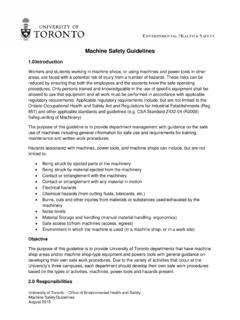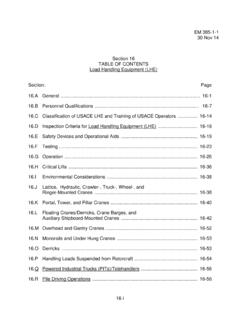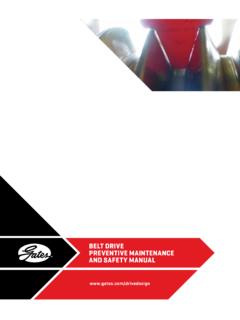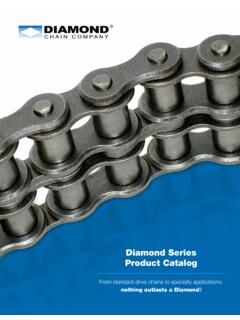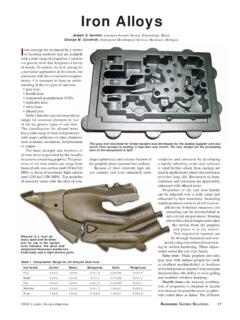Transcription of Hand and Power Tools - Occupational Safety and Health ...
1 HAND andPOWER Department of LaborOccupational Safety and Health AdministrationOSHA 30802002 (Revised) This informational booklet is intended to provide a generic,non-exhaustive overview of a particular standards-related publication does not itselfalter or determine complianceresponsibilities, which are setforth in OSHA standards themselves and the Occupational Safety and Health Act. Moreover, because interpretations andenforcement policy may change over time, for additional guidanceon OSHA compliance requirements,the reader should consult current and administrative interpretations and decisions bythe Occupational Safety andHealth Review Commission and the courts. Material contained in this publication is in the public domainand may be reproduced, fully orpartially, without permission of theFederal Government.
2 Source credit is requested but not required. This information will be made available to sensory impairedindividuals upon request. Voice phone: (202) 693-1999 For sale by the Government Printing Office Superintendent of Documents, Mail Stop: SSOP, Washington, DC 20402-9328 ISBN 0-16-049865-1 Hand and Power Tools Department of Labor Occupational Safety and Health Administration OSHA 3080 2002 (Revised) Contents iii What Is the Purpose of This Booklet? .. 1 What Are the Hazards of Hand Tools ? .. 3 What Are the Dangers of Power Tools ? .. 4 5 Operating Controls and Switches .. 5 Electric 6 Portable Abrasive Wheel Tools .. 7 Pneumatic Tools .. 8 Liquid Fuel Tools .. 9 Powder-Actuated Tools .. 9 Hydraulic Power Tools .. 11 What Help Can OSHA Provide?.. 13 Safety and Health Program Management Guidelines 13 State 13 Consultation Services.
3 14 Voluntary Protection Programs .. 15 Strategic Partnership 15 Training and Education .. 15 Electronic Information .. 16 OSHA Publications .. 17 Emergencies, Complaints, and Further 18 States and Territories with Approved Plans .. 19 OSHA Consultation Project Directory .. 22 OSHA Area Offices .. 24 OSHA Regional Offices .. 27 Contents What Is the Purpose of This Booklet? 1 This booklet is designed to present to emplo yees and employers a summary of the basic Safety procedures and safe guards associatedwith hand and portable po wer Tools . Material in this booklet is based on the standards of the Occupa-tional Safety and Health Administration; this booklet, ho wever,should not be considered as a substitute for the full Safety andhealth standards for general industry (published in Title 29 Code of Federal Regulations (CFR), Part 1910, Subpart P), or for theconstruction industry (published in 29 CFR Part 1926, Subpart I).
4 These are also available on the World Wide Web at Employers and employees in the 26 states and territories withOSHA-approved state Safety and Health plans should check withtheir state agency. Their state may be enforcing standards and otherprocedures that, while at least as ef fective as federal standards, are not always identical to the federal requirements. (See page 13for more information on state plans.) Tools are such a common part of our li ves that it is difficult to remember that they may pose hazards. Tragically, a serious inci-dent can occur before steps are taken to identify and a void or eliminate tool -related hazards. Employees who use hand and Power Tools and are exposed to thehazards of falling, flying, abrasive, and splashing objects, or toharmful dusts, fumes, mists, vapors, or gases must be provided withthe appropriate personal protective equipment.
5 All electrical connections for these Tools must be suitable for the type of tool andthe working conditions (wet, dusty, flammable vapors). When a temporary Power source is used for construction a ground-f aultcircuit interrupter should be used. Employees should be trained in the proper use of all should be able to recognize the hazards associated with thedifferent types of Tools and the Safety precautions necessary . Five basic Safety rules can help pre vent hazards associated withthe use of hand and po wer Tools : Keep all Tools in good condition with re gular maintenance. Use the right tool for the job . Examine each tool for damage before use and do not usedamaged Tools . Operate Tools according to the manuf acturers instructions. What Is the Purpose of This Booklet? 2 Provide and use properly the right personal protecti ve equipment.
6 Employees and employers should work together to establish safeworking procedures. If a hazardous situation is encountered, it should be brought immediately to the attention of the properindividual for hazard abatement. The following sections identify various types of hand and po wertools and their potential hazards. They also identify ways to prevent worker injury through proper use of the Tools and throughthe use of appropriate personal protecti ve equipment. Hand and Power Tools What Are the Hazards of Hand Tools ? 3 Hand Tools are Tools that are powered manually. Hand Tools include anything from axes to wrenches. The greatest hazards posedby hand Tools result from misuse and improper maintenance. Some examples include the following: If a chisel is used as a screwdriver, the tip of the chisel maybreak and fly off, hitting the user or other employees.
7 If a wooden handle on a tool , such as a hammer or an axe, is loose, splintered, or cracked, the head of the tool may fly offand strike the user or other employees. If the jaws of a wrench are sprung, the wrench might slip. If impact Tools such as chisels, wedges, or drift pins havemushroomed heads, the heads might shatter on impact, sendingsharp fragments flying toward the user or other employees. The employer is responsible for the safe condition of Tools andequipment used by employees. Employers shall not issue or permit the use of unsafe hand Tools . Employees should be trained in theproper use and handling of Tools and equipment. Employees, when using saw blades, knives, or other Tools , shoulddirect the Tools away from aisle areas and away from other employ-ees working in close proximity.
8 Knives and scissors must be sharp;dull Tools can cause more hazards than sharp ones. Cracked saw blades must be removed from service. Wrenches must not be used when jaws are sprung to the point thatslippage occurs. Impact Tools such as drift pins, wedges, and chiselsmust be kept free of mushroomed heads. The wooden handles of Tools must not be splintered. Iron or steel hand Tools may produce sparks that can be an ignitionsource around flammable substances. Where this hazard exists, spark-resistant Tools made of non-ferrous materials should be usedwhere flammable gases, highly volatile liquids, and other explosivesubstances are stored or used. What Are the Hazards of Hand Tools ? 4 What Are the Dangers of Power Tools ? Appropriate personal protective equipment such as safetygoggles and gloves must be worn to protect against hazards thatmay be encountered while using hand Tools .
9 Workplace floors shall be kept as clean and dry as possible toprevent accidental slips with or around dangerous hand Tools . Power Tools must be fitted with guards and Safety switches; the y are extremely hazardous when used improperly. The types of Power Tools are determined by their po wer source: electric, pneumatic,liquid fuel, hydraulic, and po wder-actuated. To prevent hazards associated with the use of po wer Tools , workers should observe the following general precautions: Never carry a tool by the cord or hose. Never yank the cord or the hose to disconnect it from thereceptacle. Keep cords and hoses away from heat, oil, and sharp edges. Disconnect Tools when not using them, before servicing andcleaning them, and when changing accessories such as blades,bits, and cutters. Keep all people not involved with the work at a safe distancefrom the work area.
10 Secure work with clamps or a vise, freeing both hands tooperate the tool . Avoid accidental starting. Do not hold f ingers on the switchbutton while carrying a plugged-in tool . Maintain Tools with care; keep them sharp and clean for bestperformance. Follow instructions in the user s manual for lubricating andchanging accessories. Be sure to keep good footing and maintain good balance whenoperating Power Tools . Wear proper apparel for the task. Loose clothing, ties, orjewelry can become caught in mo ving parts. Remove all damaged portable electric Tools from use and tagthem: Do Not Use. Hand and Power Tools 5 Guards The exposed moving parts of Power Tools need to be safe-guarded. Belts, gears, shafts, pulle ys, sprockets, spindles, drums,flywheels, chains, or other reciprocating, rotating, or mo ving partsof equipment must be guarded.










